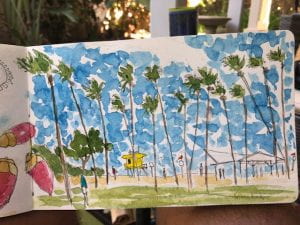In-Depth Watercolor Introduction
This year when I was asked to pick a topic/skill for in-depth to learn about I knew immediately that I wanted to work with something artistic. I have always enjoyed creative ways of art and different ways to express myself and have worked with different ways to do so. In the past, I have worked with oil painting, sketching, and charcoal drawing in abstract and realistic styles. One form of painting I wanted to learn how to work with is watercolor painting. In my opinion, I think that it is more difficult to work with because of the patients you need and the variety of techniques.

When I chose watercolor painting, specifically landscapes, there was a part of me choosing this to redeem myself. I have many times before tried to self-teach myself how to use watercolors and failed drastically. I mean that in the best way possible, I could learn from my mistake and work on it but at those times I didn’t have the patients. That makes in-depth a great opportunity to learn with the support of a mentor and motivation to succeed.
Watercolor painting is one of the more practical styles of painting. It is mostly used in a dried form, and you do not need an extensive amount of surplice to use it. My original fascination with watercolor came when I went camping as a kid and saw someone painting the view on the hike. He was just standing in the middle of the trail painting. I thought he was insane because he couldn’t sit there for hours waiting for it to dry but within minutes he had packed up and folded the painting into his pack. I later learned that though patience is a large part of painting, the lightweight and minimal supplies make it ideal for bringing outdoors. It also is less time-consuming to get the layout and basic coloring done ending still with a dry painting, asking it to vary practice for long hikes and camping trips.
During my search for a mentor, I settled for asking my parents friend from university. He, Jason Blake, has never worked professionally as a painter but has over the years taken classes and has years of experience working with watercolors. Occasionally, we meet up with their family as family friends and he always brings his paints. On hikes, he has always painted beautiful landscapes and included details that I didn’t realize make or break the paintings turn out. I thought he would be a perfect choice to have as a mentor because of his passion for painting. Jason has painted for as long as I can remember, and I can’t wait to learn more from him.

During my first meeting with Jason, I pulled up my learning contract and went over my goals to make sure he thought they were reachable. The big part of what we looked at was my set vision and goal. “By the end of my time spent on in-depth, I would like to be able to recreate landscapes from a reference with detail by merging drawing and watercolor painting. Recreating a real view onto a page while practicing two different skills and bringing them into one specific goal.” I stated as my vision, and my goal as follows. “To achieve this, I will need to look at external sources with different points of view. I will also need to keep an open mindset to achieve merging skills and have patients with finding the right techniques.” Jason and I talked about the best way for me to reach my goal and we concluded that my plan to measure my projects through bookmarks would be a good way to focus my focus on building my skills.
Before we move forward with tasks, I have created three before simple paintings and I hope to show my learning visually. I can’t wait to start learning more about watercolor painting and look forward to seeing my progress.
– Ellie Johnson